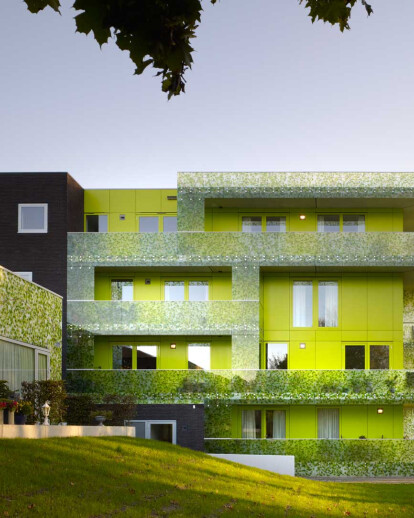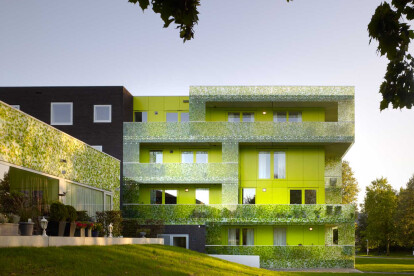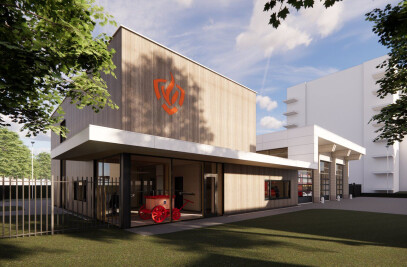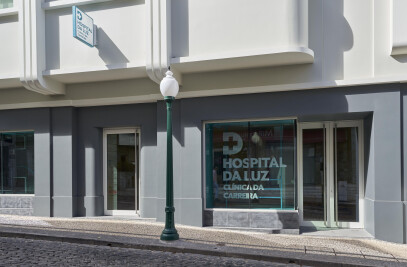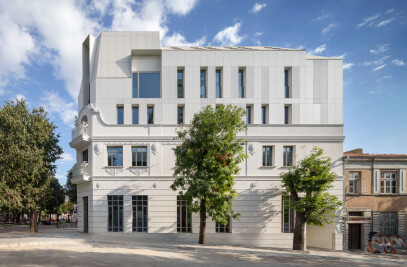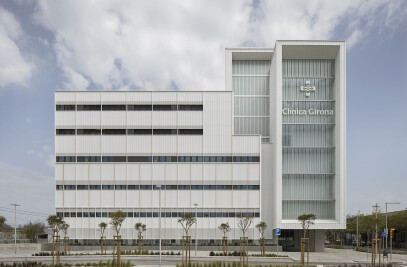Ginkgo project combines art, technology and architecture to integrate a housing complex in the nature of the existing park located in front.
CONTEXT AND PROGRAM
The project is located near the natural park of Veluwe in the Netherlands with views over an old church and the central park of the small town.
The urban structure of Beekbergen, much like most small towns in the Netherlands, is composed mainly of large single family houses that are not affordable for young people or suitable for older people with mobility problems.
'Ginkgo' project explores the possibilities of providing affordable housing for different target groups thanks to its compact housing complex, which is physically and visually integrated in its context.
The site is an interesting space located between two zones with very different characters: a green park on one side and an urban, post-war neighborhood built in the 50's on the other side.
The program consists of apartments to sell, basically for starters and people over the age of 65 and park-houses to rent.
CONCEPT
The project is based on a careful dialog between two skins that respond to the border conditions on both sides of the location:
1 The “Green Skin”
The transparency of the facade facing the park including the long balconies along the apartment block and generous terracing of the park-houses connect the dwellings both visually and physically with the park.
The glazed facade has been specially designed with a print of Ginkgo Biloba tree leaves of different green and yellow tones that react to the constant changing light of the sky creating very special effects, reflections, shadows and silhouettes, depending on the time of the day and the season of the year.
This enables privacy along the balconies and terraces, while ensuring visual connection between the outdoor spaces and the park.
Almost each printed panel of the facade is unique in order to avoid visual repetition creating a natural and organic continuous image of vegetation that wraps across the whole facade.
The printed glazed facade works as a virtual green facade that integrates the building into the greenery of the park and reduces its visual impact in the surroundings, thus giving to the building an iconic image of lightness and immateriality.
2 The “Urban Skin”
This skin wrapping the building along its front responds to the urban character of its context. The proportions of the openings of the facade and the use of brick that creates a more massive appearance to the building help the project to establish a subtle dialog with the existing post-war buildings in the neighborhood.
THE BUILDING
THE APARTMENT BLOCK
The apartment block is a compact building created by several concentric functional rings.
The vertical circulation core in the center of the block is surrounded by a first ring of collective circulation that provides access to the apartments.
The second ring concentrates all the required services of the apartments (toilets, bathrooms, kitchens, storage and installation shafts) in order to create a continuous free space in the third ring where the living areas of the house are placed. This ring is a flexible space that can be divided in many ways to offer different layouts for different ways of living. The housing types can vary from spacious lofts to three-room apartments.
The fourth ring is generated by the outdoor spaces of the houses, which are defined by long panoramic balconies surrounding the apartments facing the park and individual balconies that bring random rhythm to the facade facing the urban side.
THE PARK-HOUSES
The park-houses are designed with an extra large terrace along the upper levels with views over the park. At ground level the large glazed facade visually connects the living room with the park. A relatively small terrace on this level is only separated from the park by a modest slope that invites the users to use the park as their own back garden, thus providing a direct visual and physical connection between living room, private terrace and public park.
The semi-buried parking that covers the required parking necessities of the whole complex is hidden underneath a small hill that also guarantees privacy within the park-houses in a natural way.
ECOLOGICAL FEATURES OF THE PROJECT
IDEA OF ECOLOGY
The remarkable high density of the project compared with the neighbour detached and semi-detached houses, not only creates high quality affordable apartments for young people in the town, but also reduces in more than 80% the footprint of the building, minimizes its environmental impact and preserves the nearby valuable natural environment.
The project is designed as a very compact building with a minimum façade surface and a maximum thermal isolation value to minimize the thermal loses in winter, while it is provided with sun screens and long balconies along the south and west façades that work as natural solar protection in summer.
GREEN MATERIALS
The project has been built with durable materials that require low maintenance, some of them produced following an industrialized recycling process and most of them easy to recycle, such as the façade elements and window frames, which are made of 60% recycled aluminium and that can be 100% recycled afterwards.
Wooden elements have FSC label that ensures that the used forest products are from responsibly harvested areas and verified sources.
Extensive use of prefabricated materials and of dry connections reduces energy use and waste during the building construction and makes it eventual replacements of elements or future demolitions easier.
NATURE RESOURCES
Each apartment has been provided with an independent installation prepared for the future connection of solar panels that transform solar energy into electricity, which can be used for the consume of the house or sold back to the electricity company.
All houses are equipped with a hotfill connection for washing machines to warm the water, which avoids the use of the low-efficient electrical heating system.
The project is equipped with a separation system of wastewater and rainwater combined with a wadi system that works as a retention area for rainwater, thus avoiding flooding areas after heavy rainfall, and that irrigates the nearby green areas of the park.
